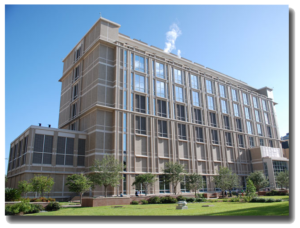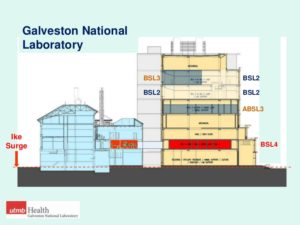This news may be just as unsettling.
https://consortiumnews.com/2017/08/30/worries-about-a-galveston-bio-lab/
Worries about a Galveston Bio-Lab
August 30, 2017
Exclusive: The flooding caused by Hurricane Harvey has left thousands homeless in the greater Houston area but there also is rising concern about a biological lab in Galveston that houses deadly diseases, notes Joe Lauria.
By Joe Lauria
Concern is rising for the safety of a biological lab containing deadly diseases on Galveston island, which has been hit by the massive storm devastating southeast Texas.

Galveston National Laboratory. (Photo credit Galveston National Library)
The Galveston National Laboratory on the campus of the University of Texas Medical Branch contains samples of hundreds of viruses, insects and microbes, which could spread extreme danger if they were to escape. There are several Bio-safety Level 4 labs at Galveston. BSL-4 is the highest level precaution taken for work with agents that can be transmitted through the air and cause fatal diseases in humans for which there are no known cures.
According to its website, the high security national bio-containment lab’s mission is to develop “therapies, vaccines, and diagnostic tests for naturally occurring emerging diseases such as SARS, West Nile encephalitis and avian influenza – as well as for microbes that might be employed by terrorists.”
There has been almost no news from Galveston as journalists have reported being blocked from reaching the island because of severe flooding. There has been no reporting at all on the condition of the lab. A call to the laboratory on Tuesday immediately went to voicemail.
The lab’s website says “plans are in place to shut down and secure all laboratory operations if a hurricane landfall is predicted near Galveston.” It says that “this shut-down and decontamination can be done quickly, with all work in the facility ceasing, the lab locked down, and all infectious agents and biological and chemical material placed into safe and secure storage.”
A 2008 article in
The New York Times about the laboratory said, “Each time a hurricane approaches the island, scientists will have to stop their experiments and exterminate many of the viruses and bacteria they are studying.”
Uncertain WarningIt is not clear how much warning the Galveston lab had. Last Wednesday the National Oceanic and Atmospheric Administration tweeted that “remnants of Trop. Storm Harvey have regenerated into a Tropical Depression.” On Thursday NOAA tweeted about “rapidly strengthening … Tropical Storm #Harvey as it moves toward #Texas.” Later on Thursday it upgraded the storm to a hurricane. On Friday it was declared a Category 2 hurricane on the same day it surged to Category 4 and made landfall.

Schematic design of Galveston National Laboratory. (Photo credit: Galveston National Library)
The lab says that its $174 million facilities have been constructed to withstand a Category 5 storm. The eight-story buildings containing the labs have pilings into the earth 121 feet deep. All the lab facilities are at least 30 feet above ground, high enough to withstand even the most severe flooding, the website said. The building is supposed to survive 140 mph winds.
The National Weather Service has called this storm “unprecedented” and “beyond anything experienced” before. The storm has so far dropped 48 inches of rain on Houston, a record for a single storm in the continental U.S. About half a million people will need help from the federal government to recover.
With electric power out to at least 100,000 customers in southeast Texas, there is fear that electricity going out at the lab would release the pressure needed to contain the deadly bugs in their secure storage containers.
“State-of-the-art systems built into the design of the GNL help protect workers and prevent any release of infectious agents,” the lab says on its website. “Double and triple redundancies in equipment and systems help ensure that if an unexpected failure does occur, a backup is in place to maintain safety.”
Generators Need FuelThe lab has back-up electric generators. In the event of a power failure, the Galveston National Laboratory “will have primary power plus independent backup power provided by multiple generators that are tested regularly,” the lab’s site said.

Hurricane Harvey’s path along the Texas coastline.
But the generators run on fuel that would have to be replenished. It is not known if the lab is accessible to emergency crews to refuel the generators, which are stored on the roof, according to the 2008
Times piece.
“As I see it the existential problem is this: What happens if and when the fuel for the back-up generators runs out?” asked University of Illinois professor Francis Boyle, an expert in biological weapons. “The negative air pressure that keeps (the) bugs in there ends. And (the) bugs can then escape.”
Boyle drafted the Biological Weapons Anti-Terrorism Act of 1989, the U.S. domestic implementing legislation for the Biological Weapons Convention. He said in an email that he believes the Pentagon should send a Nuclear, Biological and Chemical control team to Galveston to secure the lab.
The lab says it maintains “impeccable, explicit, and transparent safety standards at all levels of biological containment, consistent with federal laws and guidelines.” But Boyle points out a legal difference in language between being “consistent” with the law and being “compliant” with it.
“This is a typical lawyer’s dodge,” said Boyle, an international lawyer. “For example, Bush Jr. repeatedly stated that he would treat detainees ‘consistent with’ the Geneva Conventions, and not ‘in compliance with’ the Geneva Conventions, thus setting the basis for their abuse.”
In a 2103 incident, the Galveston lab lost track of a lethal hemorrhagic fever virus sample. It is not believed to have escaped the facility, however. The release of hundreds of samples because of a power failure could present a different scenario.
Labs Hit by HurricanesThere have been examples of severe storms causing widespread damage at bio labs. After Hurricane Katrina in 2005, the Tulane University School of Medicine “lost years of research,” according to the journal Nature Medicine. “Tulane University … sat stranded in floodwaters for weeks,” the journal reported. “When the backup generators failed, so did the freezers and refrigerators. In the sweltering heat of a New Orleans summer, it didn’t take long for the contents to spoil.”
The world’s largest collection of lymphoma samples from rhesus macaques infected with simian immunodeficiency virus was lost.
When Hurricane Ike struck Galveston in 2008, some labs on the University of Texas Medical Branch campus “lost backup power, which meant that freezers thawed,” the journal reported. It took three to four years for the university to recover. Galveston National Laboratory survived Ike, a Category 2 storm, without any damage.
When the Laboratory was built many people questioned the wisdom of putting BSL-4 labs in the path of hurricanes. “The University of Texas should consider locating its biohazards lab away from Galveston Island and out of harm’s way,” Ken Kramer, director of the Lone Star Chapter of the Sierra Club, told the Times a month before the lab opened in November 2008. “As destructive as it was, Hurricane Ike was only a Category 2 storm. A more powerful storm would pose an even greater threat of a biohazards release,” Kramer said.“It’s crazy, in my mind,” Jim Blackburn, an environmental lawyer in Houston, told the Times. “I just find an amazing willingness among the people on the Texas coast to accept risks that a lot of people in the country would not accept.”




